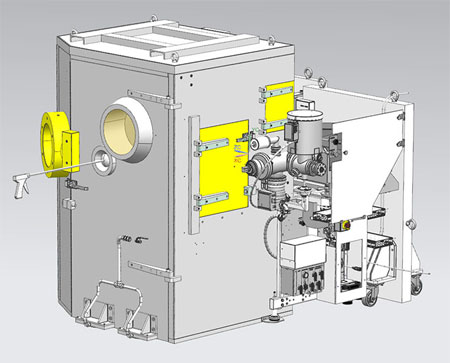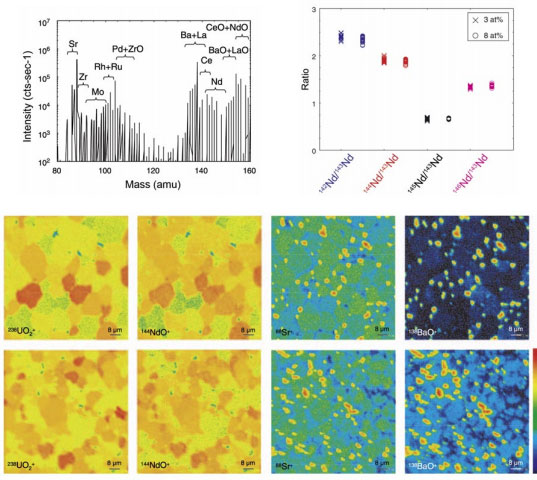ACTINIS
Shielded SIMS for highly radioactive samples
The new CAMECA ACTINIS is a dynamic SIMS (Secondary Ion Mass Spectromer) for highly radioactive fusion and fission products in nuclear science.
- High precision elemental and isotopic analysis of radioactive samples.
- Depth profiling with excellent detection limits (ppb to ppm) and high depth resolution.
- Elemental and isotopic information from low mass (H) to high mass species (Pu and above).
- Unique sub-μm resolution 2D and 3D imaging.
- Based on field-proven technology from CAMECA’s IMS 7f.
- Complete operator protection from contamination and radiation effects – including a full-security sample introduction system and minimised manual operations.
Contact us for more information and quotes:
+44 (0)1223 422 269 or info@blue-scientific.com

Example Applications
Optimising the Nuclear Fuel Cycle
Perform comprehensive analysis of complex radioactive materials, combining mass spectra, isotopic ratios and scanning ion imaging.
In this example, two samples simulating burn-ups of 3 and 8 at% were obtained by doping non-irradiated UO2 with a known concentration of elements representing fission products.
- Top left: Mass spectra on the 3 at% sample.
- Top right: Isotope measurements for four Nd ion ratios.
- Bottom top row: Ion maps of the 3 at% samples.
- Bottom low row: Ion maps of the 8 at% samples.
Data from S. Portier et al. Microchim Acta 161 (2008).
Managing Radioactive Waste from Dismantled Reactors
Dismantling old nuclear reactors generates irradiated graphite waste that must be disposed of correctly. The main contributor of radioactive dose is 14C, so it’s essential to estimate it accurately for safe waste management.
In this example, SIMS was used to characterise virgin nuclear graphite implanted with 13C. This provides insights into the effects of temperature and irradiation that influence 13C behaviour in graphite during reactor operation.
13C distribution was analysed at micrometre lateral scale. Despite the scatter, which is most likely linked to re-ordering effects, comparison of the profile areas does not reveal any notable 13C release. By extrapolating these results to the behaviour of 14C, we can calculate that reactor temperatures (200–500°C) do not induce any 14C release.
Data from G. Silbermann et al. Nuclear Instruments and Methods in Physics Research B 332 (2014).
Benchmark SIMS Performance
ACTINIS delivers high sensitivity depth profiling and isotope ratio measurements, as well as element and isotope mapping with sub-micron lateral resolution.
- Duoplasmatron and Cesium primary ion sources for sensitivity to both electro-positive and electro-negative species.
- Secondary ion-optical collection system:
- High electrical field for optimised transmission.
- Beam centering for excellent reproducibility.
- Optical gating for high dynamic range depth profiling.
- Double focusing mass spectrometer:
- Electrostatic analyser for energy focusing.
- Laminated magnet with fast peak switching.
- High precision detection system:
-
- One Electron Multiplier.
- Two Faraday Cups.
- State-of-the-art electrometry (low noise and stable baseline).
-
- Direct ion imaging for instrument tuning.
- Scanning ion imaging for mapping small to large areas with high lateral resolution.
Safety Features
CAMECA has 40+ years experience of developing microanalytical instruments for the nuclear industry, so you can be sure of optimum safety and state-of-the-art shielding.
ACTINIS can analyse samples with an activity (dose rate) of up to 2 Gy/h measured at 5cm from the sample. It’s equipped with the a glove box for Alpha protection and a lead-wall cell for Gamma protection.
Detailed specification and mechanical drawings are provided before installation, so you can equip your lab with the necessary protections for radiation safety and easy interfacing with the SIMS instrument.
Full Automation
ACTINIS offers a high level of automation. In the interests of safety, manual operations are minimised; for example there’s a full-security sample introduction system. The ion optical devices have been designed to enable maintenance within the shielding.



